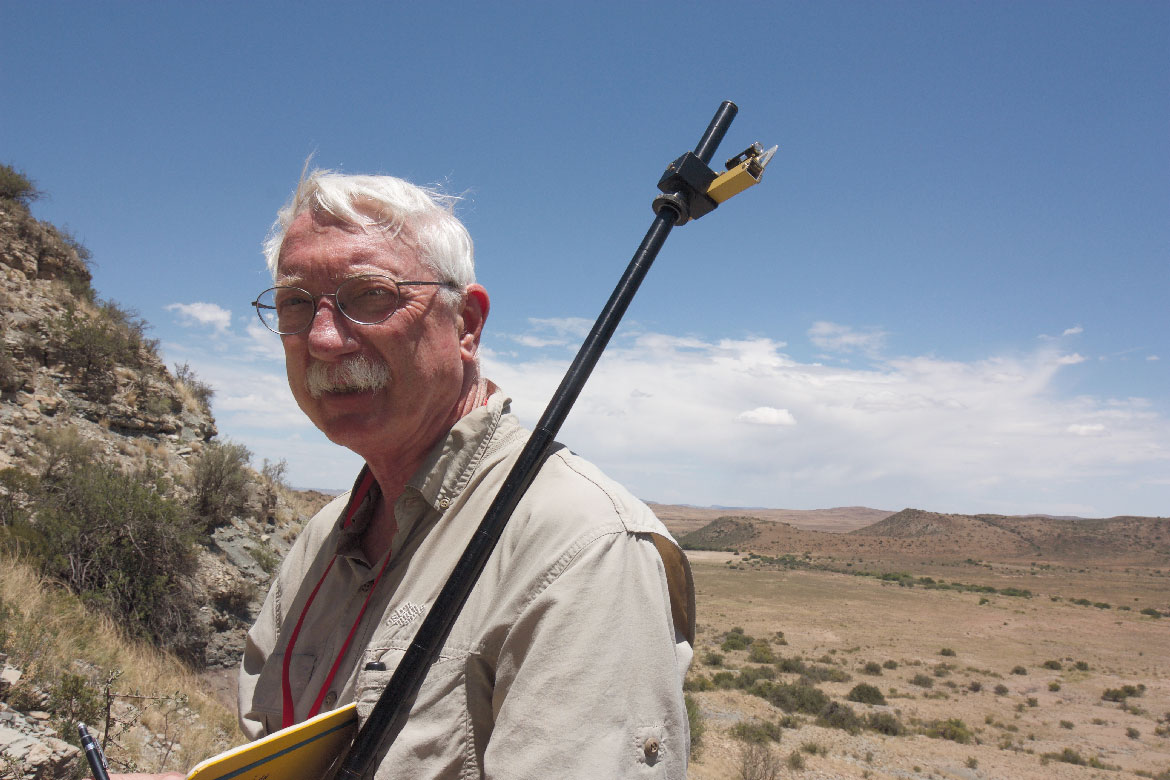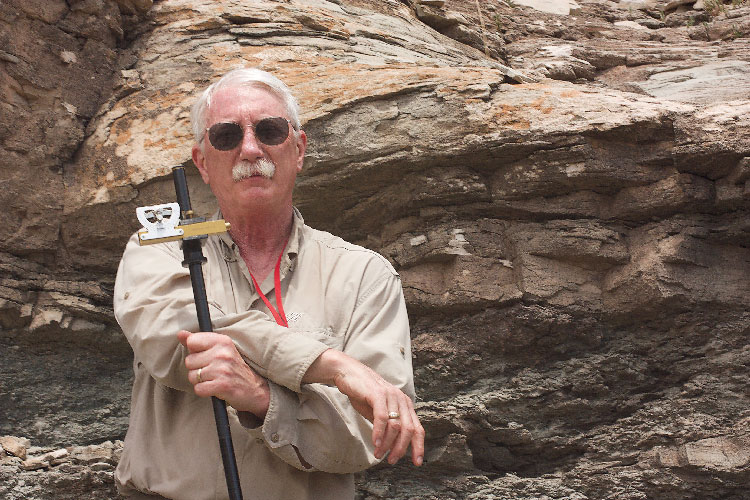
In a hotel in Bloemfontein, South Africa, a plaque on a wall in the lobby reads that the site is the birthplace of J.R.R. Tolkien, author of the famous The Lord of the Rings fantasy books. Those books sit on a shelf near a fireplace, along with The Hobbit—another book by Tolkien about an old wizard who sends the book’s main character, the titular hobbit, on an adventure. In that hotel last January, Bob Gastaldo ’72—sandaled, bespectacled, white-haired, and wizened—strolled briskly through the front door, out from the hot summer sunlight, followed by a team of geologists.
Gastaldo, a biology major at Gettysburg College, is a professor of geology at Colby College in Maine, and he was in South Africa to study rocks near the small town of Bethulie, which is about a two-hour drive south of Bloemfontein in South Africa’s semi-desert Karoo region.
The rocks he studies there are special, as they bear fossils that record the largest mass extinction to ever hit life. Known as the Permian-Triassic (PT) mass extinction, or the “Great Dying,” it is the biggest of the “Big Five” mass extinctions that interrupted the history of life on Earth. It happened about a quarter-billion years ago when about 96 percent of all marine life and 70 percent of all land life vanished forever.
Along with his team, Gastaldo brought an undergraduate student with him, Ruofei Jia, so he could teach her about the cataclysm and about how scientific research actually happens. As a mentor, he has taken about 30 undergraduate students with him to South Africa over the years.
“Even if they don’t become geoscientists, they learn how to do science, and they learn how to undertake a project—get their hands dirty,” he said.
He does this for his students because when he was a student at Gettysburg, he, too, had a mentor who guided him and who sent him on his own journey. That mentor was biology Prof. William “Bill” Darrah.
“He had a dynamic enthusiasm for what he did,” Gastaldo recalled.
Back then, for his senior project, Darrah took Gastaldo into the snow and the cold of Berwick, Pennsylvania, to collect and study the fossils of ancient ferns. There, Gastaldo felt the pull of what he called the “mystery of the ancient,” and he knew he wanted to learn more. Darrah was at his side the whole time, giving close one-on-one mentoring that helped mold Gastaldo’s professional future.
“Going to Gettysburg gave me the opportunity, in a liberal arts setting, to discover a passion,” he said.
These days, Gastaldo is still on the path that Darrah revealed to him all those years ago, both as a teacher and as a scientist. In the classroom at Colby, he encourages undergraduates to get involved in research, and he meets with his students whose research he supervises every week to check in on their progress. In the field, the mystery of the ancient still draws him to places like the Karoo. There, he wore a broad sun hat and used trekking poles to traverse the rocky landscape, where the sun beat down on rocks of browns, purples, reds, and blues, located in hills covered in brown grass and wild olive trees. He zipped about the field site, hunting for clues in rocks that might reveal secrets to how the PT extinction happened.

Between the extinction of animals on land and the extinction of animals in the oceans, the latter is much better understood than the former. For instance, it is known that the cause of the marine die-offs was probably massive volcanism in what is today Siberia, which released about 3 million cubic kilometers of basaltic lava and also gases including carbon dioxide.
In high enough concentrations, carbon dioxide can warm the planet, and one fallout effect of that was that the oceans likely became devoid of oxygen— something that would have suffocated life there. But the story of how the land extinction happened is not so well-known. That’s because it is not clear to scientists like Gastaldo whether or not the land extinction even happened at the same time as the extinction in the oceans. If it did, then climate-changing volcanism is likely to blame for the event. Otherwise, some other cause could be behind it all.
What happened is important, as many paleontologists think that humans are triggering another, sixth mass extinction of life by driving global warming via pumping carbon dioxide into the atmosphere. If global warming is part of what drove the PT extinction on land, then the PT extinction could serve as an ancient analogue for what we might expect to happen on land in the future. However, the verdict is still out on when the extinction happened, which is why Gastaldo continues to study rocks in South Africa.
This year, Gastaldo worked with his team and Jia to solve the mystery. Jia explained that she had become a geology major, and had traveled out to the Karoo, in large part because of the enthusiasm of professors like Gastaldo.
Recalling the two of them at work, it is not hard to see the teaching legacy that began with Bill Darrah at Gettysburg and which continues through Gastaldo and his mentorship of students. Perhaps one day Jia will beckon others on similar such adventures, and a tradition that began at Gettysburg will continue.